School of Scottish Studies
University of Guelph, Ontario
Fall Colloquium
Saturday, 28 September 2002
By W. Neil
Fraser, Chairman
Clan Fraser Society of
Canada
The theme of the all-day colloquium conducted by the
School of Scottish Studies at University of Guelph was "(Re)-Inventing the
Scottish Tradition" which was attended by some 110 people. Representatives
from the University included Dr. Jacqueline Murray, Dean of the Arts
Department and Drs. Elizabeth Ewen and Linda Mahood from the History
Department. Dr. Kevin James, Chair of Scottish Studies, welcomed the large
audience and explained the Scottish Studies program at Guelph that now
attracts some 500 registrants each year including undergraduate and
graduate students as well as doctoral candidates in Scottish history. The
Scottish Collection at the University of Guelph Library is now considered
to house the largest collection of Scottish books, periodicals and
documents outside of Scotland, including some rare editions not found in
Scotland.
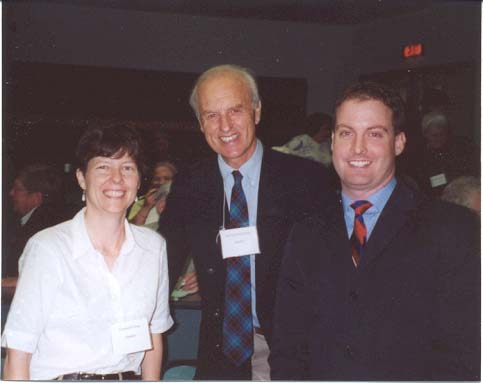
Dr. Elizabeth Ewen, Dr. Ian Maitland Hume, Dr. Kevin James
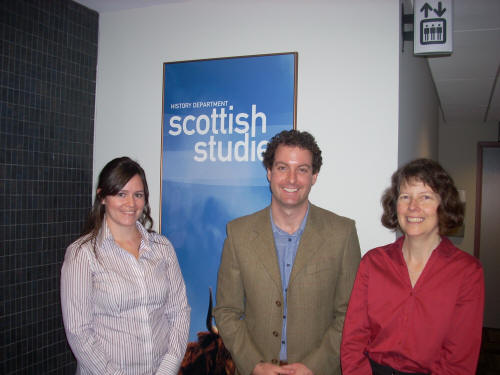
Here is a more recent photograph of Dr Kevin James
The first paper entitled "Tartan and the kilt – symbols
of the past or present?" was presented by Dr. Ian Maitland Hume, a
graduate of University of Edinburgh who now lives in Berwickshire in the
Scottish Borders. Dr Hume began his presentation by showing many of the
earliest paintings of a gentleman in kilt and Highland dress, the oldest
being of Lord Murray in the 1680s. The 1714 painting of the Piper to Grant
and a 1745 painting of James Murray provided examples of pre-Culloden
tartans and Highland wear.
Dr. Hume traced the suggested history of tartan and the
kilt based on writers such as Tom Nairn, Trevor Roper, David Macrae and
Hugh Cheape to illustrate how tartan and Highland wear have evolved from
being the primary identity of the Highlander to what is now considered to
be the national dress of Scotland. He commented that the transition is an
invented tradition that sought to provide continuity with the past, and
has been exploited for tourism purposes but is gradually being returned to
the people in Scotland. He showed the famous painting of the Battle of
Culloden with Highlanders wearing various tartans, and the painting of
King George IV in full Highland costume during his visit to Edinburgh in
1822. Dr. Hume pointed out that the artist carefully avoided depicting the
pink tights the King wore, no doubt in hopes of being paid for the
painting.
He explained the 1747 Proscription against wearing of
tartan and Highland dress, which lasted for 34 years before being reversed
through the influence of the Highland Society of London. He commented on
the Highland Regiments being the only legal way to wear the kilt and
tartan, and the role that these regiments played in recruiting able-bodied
men from all areas of Scotland. He showed several paintings of various
members of the gentry in full Highland dress, painted during the time of
the proscription, and he explained how the kilt and tartan thus became
largely associated with the local gentry during that era.
Dr. Hume compared the adoption of "national dress" by
Norwegians in gaining independence, with a similar recent phenomenon in
Scotland. He explained the growth of kilt rental firms in Scotland and
estimated that at 95-per-cent of the weddings held in Berwickshire today,
the groom and male members of the wedding party wear the kilt and Highland
wear, although neither were ever historically associated with the Scottish
Borders. He showed photos of people like Sean Connery. Michael Forsythe
and the Lord Provost of Edinburgh in kilt and Highland garb, and he
suggested that none of them had likely ever worn the kilt until recently.
He mentioned that the Lord Provost wears five different tartans, none of
which have any connection to his name. When asked about it, the Lord
Provost told a reporter he just liked to wear a variety of colours. Dr.
Hume’s favourite photo featured Mohammed (Al) Fayed wearing a kilt of the
specially designed Harrod’s Tartan, sitting on a bench reputedly made of
Oak from William Wallace’s Oak tree. To round off his presentation, he
showed several photos of the Singh family, all attired in the kilt of the
officially registered Singh Tartan, and their heads adorned with the
traditional turban. The elder Singh is a Baron in Scotland, with his own
coat of arms, and his children are all proud Scots now.
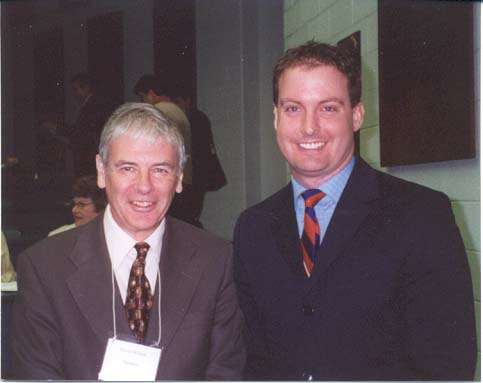
Dr. David Wilson, Dr. Kevin James
The second paper entitled "The Celtic Myth in Scott’s
Waverley" was presented by Dr. David Wilson, a native of Ireland, who is
Head of the Department of Celtic Studies at University of Toronto. He
suggested that the notion of Scots being "Celtic" is relatively recent
(post 1707), prior to which time the people in Scotland had never defined
their race as Celtic. He attributed the phenomenon to a defense by some
rural Scots against the Industrial Revolution, which was well established
in England and the central belt of Scotland. The view of the English and
Scots in the larger cities was that the Scots who lived north were
primitive, irrational, savage, and they were often compared with the North
American Indians. To counter that view, many northern Scots responded by
claiming that primitive was merely traditional; irrational equated to
passionate; and superstitious became spiritual. In one bizarre analogy,
Adam and Eve spoke Gaelic, while their servants spoke English. The Irish
had saved civilization, and the Welsh, Irish and Scots were equated with
the artistic, while the English were not. Thus, the many myths associated
with the Celtic culture of Ireland and Wales were adopted by some Scots to
defend against a change in their rural way of life in the face of
inevitable adoption of more modern practices.
Dr. Wilson made reference to the Macpherson
"translations" of the Poems of Ossian, which remain controversial to this
day. That Sir Walter Scott recognized the "Oral Tradition" suggests that
Macpherson had the misfortune to be born too early. Had he waited a bit,
he may well have been a famous historical novelist like Scott. Dr. Wilson
used Scott’s character Edward Waverley, an Englishman caught up in the
Jacobite Rebellion fed on fantasy and legend, to explain how Waverley
preferred the romantic life to that of the humdrum everyday life. Dr.
Wilson suggested that Sir Walter Scott regarded Waverley an imbecile for
his blind loyalty to Bonnie Prince Charlie until he considered responding
to his own good sense and reason. When he did, he realized that James, the
Old Pretender had forfeited his own reason and plunged Britain into a
civil war. Therefore, in Dr. Wilson’s view, their reasoning equated with
loyalty to the government, while passion meant loyalty to the Jacobite
cause.
Waverley suffered a series of shocks after joining the
Jacobite Army, including finding the dead body of the son of his
neighbour, and was consumed with guilt. In the classic romantic ending,
romantic heroes always die. In the end result the Highland "Celts" passed
out of history, but their image lives on with the English and Scots
working together within the Union. Dr. Wilson suggested that Sir Walter
Scott was ambivalent in his representation of the Highlander as both a
savage and a romantic hero.
To provide some relief from the academic presentations
the Halton-Peel Region Burns Club, a representative from a volunteer group
near Toronto, read from a selection of Burns’ poetry and performed some of
the bard’s famous songs, before lunch. Prior to the start of the
colloquium and during the breaks, there was a sale of surplus books from
the University of Guelph Library’s Scottish Collection, many from donated
collections, including a few rare books from Scotland. The surplus book
sale is always popular with attendees, and the proceeds are used for
future acquisitions, to enhance what is now considered the largest
collection of Scottish books and periodicals outside Scotland.
Following the luncheon break a panel comprised of Rob
Falconer, a PhD candidate at University of Guelph School of Scottish
Studies; Dr. Sarah Tolmie, Professor of History, University of Waterloo;
and Dr. Scott-Morgan Straker, Professor of History, Queen’s University,
Kingston, Ontario, discussed "Mediaeval and Early-Modern Scotland".
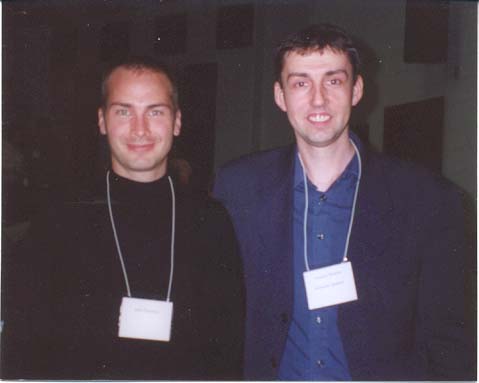
Rob Falconer, Dr. Graeme Morton
Rob Falconer’s paper was entitled "The King’s Probi
Homines: A royal perception of nationhood". He commented on Robert
Bruce’s attempts to gain support in Ireland, and the incoming Normans who,
he suggested did not feel in conflict with the people in Scotland at the
time, including the Picts. Scotland had three distinct societal groups –
the King, the landowners and the people, who all formed part of the
greater Scottish community. In effect, Scotland was an early "melting pot"
nation with Anglians, Flemish, Norse, Normans, Picts and Celts.
Dr. Sarah Tolmie’s paper was entitled "Barbour’s
Bruce: The King as a Political Animal". She explained the political
intent of the poem "The Brus" by poet John Barbour (c1320-95), sometimes
called the father of Scottish vernacular poetry. Barbour, who became the
Archdeacon of Aberdeen in 1357, used his poetry to trace the Wars of
Independence from their origins through Bannockburn, to the Irish wars and
the deaths of Bruce and the Black Douglas. His works have been declared a
Romance, and he departed from historical accuracy when it suited his
purpose. The idea of liberty is retained in its purity by grafting the
patriotic deeds of Robert I’s grandfather (Bruce the Competitor) onto his
grandson’s later life, thereby omitting reference to the early period when
Robert I served the English.
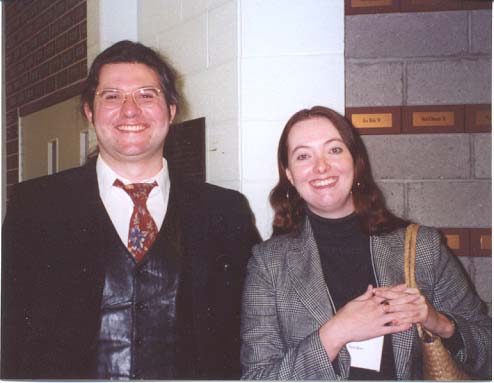
Dr. Scott-Morgan Straker, Dr. Sarah Tolmie
Dr. Scott-Morgan Straker’s paper was entitled "The
Kingis Quair as a Flight from Politics". He reviewed four quotations
from the poem, written in Old Scots, and attempted to provide a modern
explanation of their meaning. I’m afraid poetry written in Old Scots is
not one of my great interests, which could be interpreted as a kind way of
suggesting that I find the subject dead boring. To illustrate, I offer a
few lines from the following quotation:
I mene this by myself, as in partye,
Though Nature gave me suffisance in youth,
The rypenesse of resoun lakkit I
To governe with my will, so lyte I couth,
Quhen stereles to travaile I begouth,
Amang the wavis of this warld to drive —
And how the case I will discrive.
Dealing with such a subject after the lunch break is
not an easy task for the presenter. If I felt guilty about my lack of rapt
attention, I was not alone, as I noticed a few in the audience who had
actually nodded off for an impromptu afternoon nap. Granted, mediaeval
Scottish history is not the most exciting subject, at the best of times.
Fortunately, the afternoon coffee break followed and
the audience returned, refreshed and ready to listen to the keynote
address "Scottish Nationalism and the Uses of History" by Professor Graeme
Morton, University of Edinburgh. Dr. Morton is a tall young Scot with a
priceless sense of humour, and an outspoken critic of the way such
legendary "heroes" as William Wallace have been exploited for political
purposes by modern Scottish nationalists, particularly in the wake of that
historical gem of a film "Braveheart".
Dr. Morton used a computer-generated slide presentation
to illustrate his points about the way Scottish historiographical
literature has been selectively exploited for political advantage – thus
comparing it to a list of militaristic, great lives, political, social and
cultural attempts to fragment history. He used William Wallace as a
perfect example. There is no documented evidence of Wallace’s date of
birth, only the account of his cruel death at the hands of Edward I in
1305, and tales of his exploits at various times in early Scottish
history. While there is no way to know what William Wallace really looked
like, that has not stopped generations of artists and sculptors from
creating supposed likenesses of Wallace, and Dr. Morton presented a large
sampling of images depicting the legendary hero. His personal favourite is
a poster of Mel Gibson who, complete with blue paint on his face, now IS
Wallace to the world.
In reviewing slides of the dozens of monuments of
Wallace, Dr. Morton noted that most depicted an image somewhere between
Jesse Ventura and Hulk Hogan; at least 6’-5" tall, muscular, and
invariably carrying a scroll under his arm. Dr. Morton is not convinced of
the authenticity of the so-called "Leubeck Letter", and got a lot of
laughs when he kept pointing out that the ever-present scroll depicted in
the various statues could very well have been the famous letter, before it
was sent off by a courier to Germany.
Most statues of Wallace project a larger-than-life
image, save one monument erected in 1819 in Ayr. The builders of the
monument decided to complete the structure, including the decorative niche
intended to receive the statue of Wallace being sculpted elsewhere, before
the statue was completed. Therefore, when it came time to install the
statue in the niche, Wallace was too tall to fit the available space. What
to do? With characteristic Scots ingenuity and frugality, the statue was
shortened to fit the space in the niche, and "Brave Wallace" came out
looking like a 4’-6" dwarf. Dr. Morton refers to that one as "The Wee
Wallace".
Dr. Morton suggested that with William Wallace, it is
the story that counts and facts don’t matter; it is a myth, and in
politics the myth is more important. He drew comparisons between the
stories about William Wallace, and those translated from the poetry of
"Blind Harry" (1474-79), which may have been the basis for much of the
Wallace image we know today. The poems were supposedly based on the "oral
tradition" – some evidence of him being real, but subject to
interpretation both by the translator, and the reader of the translation.
Dr. Morton raised some interesting questions about "Blind Harry", who was
supposed to have been born blind. If true, how did he manage to "see" his
subjects, learn Latin and French and do the necessary research for his
historical poems? His poems, with their excessive spilling of English
blood, suited the purpose of Scottish nationalists, and certainly provided
the required exploits for a hero figure of the stature of William Wallace.
Holding the rapt attention of an audience that has been
sitting all day listening to dissertations on Scottish history can be a
challenge for the final speaker. Dr. Morton used his dry sense of humour
and obvious knowledge of his subject to keep everyone amused and
interested. If there were any closet Scottish National Party supporters in
the audience, they may not have appreciated Dr. Morton’s comments about
William Wallace, but the vast majority who did so, showed their
appreciation with a hearty round of applause, before heading home. I have
attended numerous colloquia at Guelph since the early 1990s, but have
seldom enjoyed one more — which only proves that those speakers who are
able to add a wee touch of humour to their presentation can make the
dullest subject come to life, and make their presentations more memorable.
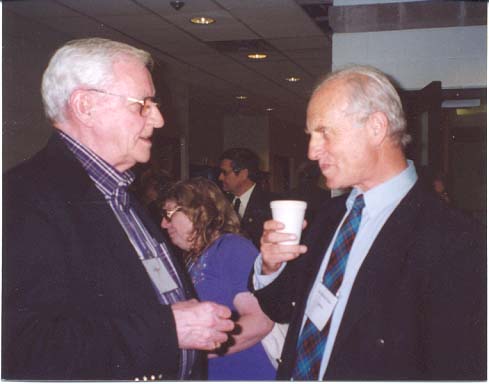
Neil Fraser, Dr. Ian Maitland Hume
Photos: Marie Fraser

